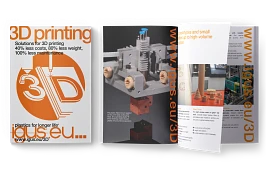Change Language :
3D printing wiki
Technical information about 3D printing at igus
Find out here how to use additive manufacturing successfully with wear-resistant plastics to increase the service life of your applications and reduce production costs. On this page, our 3D printing experts share their know-how about design, material selection and manufacturing for industrial requirements.
On-demand webinars and live streams
How do you successfully process filaments in your own 3D printer?
Development engineer Niklas Eutebach shares his practical knowledge of 3D printing with filament and gives tips on material selection, processing and reworking.
Which igus tribofilament is the right one for my application?
In addition to tips on material selection, the in-house processing of filaments is compared with ordering components from the 3D printing service.
Multi-material 3D printing for intelligent or extremely rigid components
Would you like to combine the advantages of different materials in one component? Then discover the creative possibilities igus offers!
Food conformity with wear-resistant components - what is possible?
Find out more about igus's materials, 3D printing processes and reworking options for the food industry.
Why print gears in 3D instead of milling them?
What are the advantages of 3D-printed gears over milled gears? Find out how you can quickly design your 3D gear with the igus CAD configurator.
Three common mistakes when 3D printing gears
Avoid the mistakes mentioned in the webinar to maximise the benefits of 3D-printed plastic gears in industrial applications.
3D printing of gears: faster to series production thanks to service life calculation
With the help of the igus gear service life calculator, you can significantly reduce trial periods and testing times. Find out here how this online tool works.
Additive manufacturing in series production: five application examples with "cost down, life up"
With 3D-printed components made from igus plastics, you can reduce costs and increase service life. Which applications offer great potential for this?
Design instructions and printing tips

Design special lead screw nuts for 3D printing
The production of complex special nuts often involves a great deal of manual effort, which can quickly make such solutions very expensive. In this case, 3D printing technologies help reduce costs - but they also require a 3D model of the desired thread. You can find out how to create CAD models for special nuts in this article.

Design tips: multi-material components from the 3D printer
When using filaments for 3D printing, components can be produced from two or more materials. There are a few things to consider when designing such components digitally with CAD programs. For example, how do you ensure that the different materials overlap smoothly in the same component? You can find answers to this and other questions in this article.

How do I replace my defective gear?
Machine downtime due to a defective gear in the gearbox is extremely inconvenient. The gear should be replaced immediately. In such a case, the 3D printing service from igus offers a fast and reliable replacement option. How do you get a new, wear-resistant gear from 3D printing step by step and without CAD knowledge?

Food-safe filament in 3D printing (best practices)
Not all materials are suitable for contact with food. Special requirements must be observed when printing food-safe parts with filaments in 3D. These include, for example, information on printing conditions and the correct storage of filament spools. We have compiled all the relevant information for you.

How do I use the igus bonding agent for tribofilaments?
Especially with demanding filaments, it can happen that the component does not adhere properly to the print bed. As a result, the corners of the component can separate from the print bed, leading to undesirable deformations. In the worst case, the component can even become completely detached from the print bed. Solve this problem now with the igus® bonding agent!
Free e-papers and downloads

3D printing design guide
Design guide for components manufactured via the 3D printing service, including practical tips that help extend service life.
Download the design guide
Guide to filament 3D printing
This guide provides 24 tips for 3D printing with filament to help you avoid common printing problems easily.
Download guide
3D printing industry brochure
Our solutions for 3D printing: from materials to tools for CAD design and the online printing service to printer construction.
Download brochure
Guide for 3D printing of gears
In this guide, you can find out everything about the three most common mistakes made when printing gears in 3D, and how to avoid.
Download guideDesign data for printer construction

Build your own large-scale 3D printer and print components or up to 1m in size.
To the data
A high-temperature 3D printer can be very expensive! Save money and build your own one now.
To the dataDo you have any questions or suggestions or are you interested in workshops and learning material on specific topics? Please don't hesitate to write to us!
Consulting
I look forward to answering your questions

Shipping and consultation
In person:
Monday to Friday from 7 am - 8 pm.
Saturdays from 8 am- 12 pm.
Online:
24h
WhatsApp-Service:
Montag – Freitag: 8 – 16 Uhr




